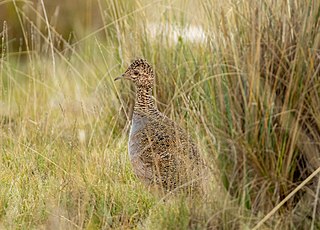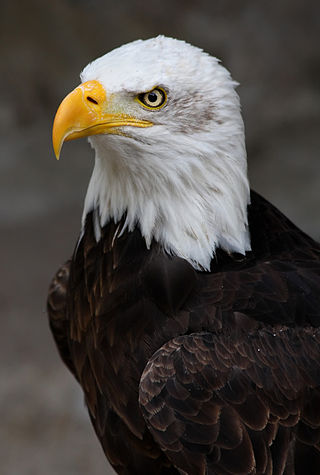Related Research Articles

The Accipitriformes are an order of birds that includes most of the diurnal birds of prey, including hawks, eagles, vultures, and kites, but not falcons.

The cotingas are a large family, Cotingidae, of suboscine passerine birds found in Central America and tropical South America. Cotingas are birds of forests or forest edges, that are primary frugivorous. They all have broad bills with hooked tips, rounded wings, and strong legs. They range in size from 12–13 cm (4.7–5.1 in) of the fiery-throated fruiteater up to 48–51 cm (19–20 in) of the Amazonian umbrellabird.

The American Ornithological Society (AOS) is an ornithological organization based in the United States. The society was formed in October 2016 by the merger of the American Ornithologists' Union (AOU) and the Cooper Ornithological Society. Its members are primarily professional ornithologists, although membership is open to anyone with an interest in birds. The society publishes the two scholarly journals, Ornithology and Ornithological Applications as well as the AOS Checklist of North American Birds. The American Ornithological Society claims the authority to establish standardized English bird names throughout North and South Americas.
The Magdalena tinamou, Crypturellus erythropus saltuarius, is a member of one of the most ancient bird families, the tinamous. It is endemic to the Magdalena River Valley in Colombia, and had been considered possibly extinct, because of an absence of confirmed records since the type specimen was collected in 1943. The most recent review consider it likely that it is extant, as locals have reported sightings in the 1970s and 1980s, an individual was apparently held in captivity until the early 1990s, and a few patches of forest remain in its presumed range. Additionally, a record was made in late 2008. It was rediscovered in 2023.

The red-winged tinamou is a medium-sized ground-living bird from central and eastern South America. Other common names for the species include perdiz grande, rufous tinamou, and ynambu.

The red-legged tinamou or red-footed tinamou, is a ground-dwelling bird found in the tropics and lower subtropics of northern South America.
The Colombian tinamou, Crypturellus erythropus columbianus, is a tinamou found in Córdoba, Sucre, Bolívar, and Antioquia in north-central Colombia. Little is known about it. It occurs in lowland moist forest and shrubland at elevation up to 600 m (2,000 ft).

The ornate tinamou is a type of tinamou commonly found in the high altitude grassland and dry shrubland in subtropical and tropical regions of west central South America.

The huayco tinamou, also known as waypu (Quechua), is a species of bird found on grassy mountain ridges in the Andes of Bolivia and Argentina.

Catamenia is a genus of atypical seedeaters. Formerly placed in the Emberizidae, they are now placed in the tanager family Thraupidae.

The rufous-capped thornbill is a species of hummingbird in the "coquettes", tribe Lesbiini of subfamily Lesbiinae. It is found in Bolivia, Ecuador, and Peru.

The fulvous wren is a species of bird in the family Troglodytidae. It is found in Bolivia and Peru.

Cinnycerthia is a genus of bird in the wren family, Troglodytidae. It contains four species which inhabit the undergrowth of montane forests in the Andes. None of them are considered to be threatened with extinction and they are classified as species of Least Concern by BirdLife International. They are 14–16.5 cm long and have a fairly short bill and fairly plain reddish-brown plumage with dark bars on the wings and tail. The name of the genus is a combination of Cinnyris, a genus of sunbirds, and Certhia, a genus of treecreepers.

The swallow-tailed cotinga is a species of passerine bird in the family Cotingidae. It is the only member of the genus Phibalura.

Nothoprocta is a genus of birds belonging to the tinamou family Tinamidae. They inhabit scrubland, grassland and open woodland in western South America, particularly in the Andes. They are poor fliers and spend most of their time on the ground. Their diet includes seeds and insects. They nest on the ground, laying large glossy eggs. The eggs are covered with feathers when a potential predator is nearby.
The Santa Marta tinamou, Crypturellus erythropus idoneus, is a subspecies of tinamou that was recognized as a species by most authorities until 2006. It is found in northern South America.

Accipitrimorphae is a clade of birds of prey that include the orders Cathartiformes and Accipitriformes. However, this group might be a junior synonym of Accipitriformes. The DNA-based proposal and the NACC and IOC classifications include the New World vultures in the Accipitriformes, but the SACC classifies the New World vultures as a separate order, the Cathartiformes which has been adopted here. The placement of the New World vultures has been unclear since the early 1990s. The reason for this is the controversial systematic history of the New World vultures as they were assumed to be more related to Ciconiidae after Sibley and Ahlquist work on their DNA-DNA hybridization studies conducted in the late 1970s and throughout the 1980s. The stork-vulture relationship has seemed to not be supported. Regardless of whether to use Accipitrimorphae or Accipitriformes, these birds belong to the clade Telluraves.

The painted manakin is a small South American species of passerine bird in the manakin family Pipridae. It was first described in 2017 from specimens collected in north west Peru.

The Apolo cotinga or palkachupa cotinga is a species of passerine bird in the family Cotingidae. It is a member of the genus Phibalura.

The yellow-lored tanager, also known as the olive tanager, is a species of bird in the cardinal family Cardinalidae that is found in South America along the eastern foothills of the Andes from southern Colombia to western Bolivia. It was formerly considered to be conspecific with Carmiol's tanager of Central America.
References
- 1 2 3 J. V. Remsen Jr.: The South American Classification Committee of the American Ornithologists’ Union: a new classification of the birds of South America In: Neotropical Birding, July 13, 2007, pp. 21–23
- 1 2 3 4 5 6 The American Ornithologists' Union: William Brewster Memorial Award, 2013: J. V. (“Van”) Remsen Jr. In: The Auk, 130(4):819–820.
- ↑ Ornithological Monographs" 63: 1-114.
- ↑ Proposal (1) to South American Classification Committee Elevate "Rhynchotus maculicollis" to species rank
- ↑ Banks, R. C., B. L. Monroe Jr., J. W. Fitzpatrick, T. R. Howell, N. K. Johnson, H. Ouellet, J. V. Remsen Jr., and R. W. Storer. 1998. "Check-list of North American Birds". 7th Edition. American Ornithologists' Union, Washington, D.C., 829 pp.
- ↑ Remsen, J. V. and Brumfield, R. T. (1998) Two new subspecies of "Cinnycerthia fulva" (Aves: Troglodytidae) from the southern Andes. In: Proc. Biol. Soc. Washington 111(4): 1008–1015.
- ↑ "The Howard and Moore Complete Checklist of the Birds of the World. Vol. 1. Non-passerines. Aves Press, Eastbourne, UK, 461 pp.
- ↑ Mark B. Robbins, Gary H. Rosenberg, Francisco Sornoza Molina: A New Species of Cotinga (Cotingidae: Doliornis) from the Ecuadorian Andes, with Comments on Plumage Sequences in Doliornis and Ampelion. In: The Auk. Bd. 111, Nr. 1, January 1994, pp. 1–7